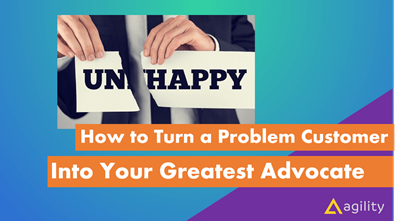How to Turn a Problem Customer Into Your Greatest Advocate
Creating perfect Customer Experiences can be hard.


Relationships can be hard.
In our personal lives, our time is super-valuable, so we guard every precious moment we can to spend time with people we care about the most. At work, it's not much different; we often spend more time with colleagues that make us happy, or who we relate to more easily.
What about our customers, though? Who do we find ourselves focusing on the most? And who do we find ourselves avoiding? In theory, we want all of our customer relationships to be great, but sometimes the reality is a little different. It can be hard to ensure all of your customers are happy, and sometimes you drop the ball. You make a mistake, and something happens outside of your control, and... BOOM!
Somebody is pissed.
You have a fire to put out.
Maybe it happened all at once, but more likely, it happened over time, and you didn't see it happening, or perhaps you chose not to see it. I'm not going to judge - hey - I've been there!
Here are 5 steps to start turning that relationship around.
Step 1: Make sure your business isn't TRYING to make this customer upset.
This is truly the worst-case scenario. If you work for a company whose policy it is to piss off this customer, you're in trouble. If you say to your boss "Hey, I need to do something to fix this for my customer" and the answer is, "that's not our problem" or "it's their own fault, they shouldn't have done X, Y, Z" then you are not going to solve this quickly.
You have to choose between the customer and the status quo. You might get in trouble, and you might have to go out on a limb.
Step 2: Apologize Immediately And Take Full Responsibility
This is important. You may think to yourself, well, what if it wasn't all my fault? I CAN'T take responsibility if it wasn't my fault!
It doesn't matter. Just apologize and start the process of working back the clock on this customer's relationship with your company.
As part of your apology, promise to get to the bottom of the issue, the root cause, as best you can.
Step 3: Find Out Why
You need to know everything. Ask questions, search your emails, turn over every rock. You have a customer in need, and that should be your greatest motivation to find the truth of what's actually happening to cause their angst.
When you are seeking a root cause, remember to keep your customer's viewpoint in mind. It doesn't matter what YOU think is the problem, it only matters what THEY believe.
Once you discover the issue, and what caused it, now you have to act.
Step 4: Make a Promise
You may not have an answer yet, but at this point, you should know what that the problem is.
Now you have to make a leap of faith.
You have to promise your customer that you are going to make things better. You are going to do your best, and you aren't going to stop until they are satisfied. And you have to mean it, which means you have to be willing to do whatever it takes, utilize whatever resources, drink cups of coffee, burn the midnight oil until you have a solution that works for your customer.
Remember, this solution might not be optimal for you. It might mean you have to give up something. It could be that you CAN'T fix the problem - that doesn't matter. You need a solution, and it has to be real, and it has to be in the best interest of your customer.
Step 5: Make It Right
Sometimes we feel like we should just jump to this step. Skip 1-2-3-4 - don't bother with all the research and the promises and the late nights - just FIX it!
That would have worked before there was a problem, but it won't work now. You need to be more effective than that. You need to turn this ship around, and your customer isn't stupid. You can't short-circuit this relationship from bad to good.
So, you carefully head through Step 1 to 4 on this checklist, and you end up here. Get this problem solved as quickly as possible. It may not be an immediate fix. Tell your customer if you need time, be honest. This is your chance to start building up you "emotional bank account" with them, so make sure it's legitimate. Start doing things that your customer can believe in, and the trust will start to build up.
It could be that you can't solve this COMPLETELY right away. That's ok, you may need to initiate a phased approach. Write up a plan, make sure it's feasible, push it through whatever approval process it needs to go through and get started. The sooner you can show your customer that you're solving their problem, and working hard for them, they will start seeing the world through your lens.
It's actually kind of like magic. At the beginning of the process, everyone is pissed, and nobody wants to listen to anyone. Once you take the initial step of changing your perspective and looking at the world how your customer sees is, everything starts to change.
By the time you finish Step 5, you'll be talking to your customer in a whole new way. And guess what? They'll be talking about YOU in a whole new way to everyone else.
May the force be with you.

About the Author
Joel is CTO at Agility. His first job, though, is as a father to 2 amazing humans.
Joining Agility in 2005, he has over 20 years of experience in software development and product management. He embraced cloud technology as a groundbreaking concept over a decade ago, and he continues to help customers adopt new technology with hybrid frameworks and the Jamstack. He holds a degree from The University of Guelph in English and Computer Science. He's led Agility CMS to many awards and accolades during his tenure such as being named the Best Cloud CMS by CMS Critic, as a leader on G2.com for Headless CMS, and a leader in Customer Experience on Gartner Peer Insights.
As CTO, Joel oversees the Product team, as well as working closely with the Growth and Customer Success teams. When he's not kicking butt with Agility, Joel coaches high-school football and directs musical theatre. Learn more about Joel HERE.
